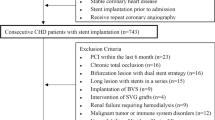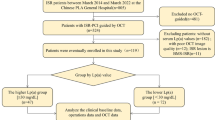Abstract
Purpose
High levels of apolipoprotein B (apo B) are a risk factor for the development of major vascular events. We evaluated the association between plasma lipoproteins and the development of superficial femoral artery (SFA) in-stent restenosis and reocclusion in patients with peripheral artery disease.
Materials and Methods
We included 139 patients with SFA stenting. Plasma lipoproteins were measured after stent implantation. Stent restenosis was assessed with duplex scan after 3, 6, and 12 months. A stenosis grade was considered relevant if >50%.
Results
Seventy-two patients experienced recurrence of their atherosclerotic disease, meaning restenosis of >50% within 1 year of follow-up. Ten of these patients had a stent occlusion. In the patients who experienced recurrence, the mean apo B level was 105.8 versus 94.9 mg/dl in patients without recurrence (P < 0.05). Patients without recurrence had higher high-density lipoprotein cholesterol levels than patients with recurrence (39.7 vs. 34.7 mg/dl, P < 0.05). Comparing patients with a stent occlusion (n = 10) and those with a restenosis of 75–99% (n = 28), the patients with a stent occlusion had higher levels of plasma cholesterol (234.1 vs. 185.9 mg/dl, P < 0.05), apo B (135.3 vs. 99.8 mg/dl, P < 0.05), low-density lipoprotein cholesterol (160.3 vs. 113.6 mg/dl, P < 0.05), and low-density lipoprotein apo B (115.5 vs. 82.4 mg/dl, P < 0.001) than the patients with restenosis of 75–99% (n = 28).
Conclusion
Changes in the lipid profile could be one reason for the development of restenosis and for the development of reocclusion after SFA stenting.
Similar content being viewed by others
References
Sniderman AD, Furberg CD, Keech A et al (2003) Apolipoproteins versus lipids as indices of coronary risk and as targets for statin treatment. Lancet 361(9359):777–780
Graham I, Atar D, Borch-Johnsen K et al (2007) European guidelines on cardiovascular disease prevention in clinical practice: executive summary. Eur Heart J 28:2375–2414
Walldius G, Aastveit AH, Jungner I (2006) Stroke mortality and the apoB/apoA-I ratio: results of the AMORIS prospective study. J Intern Med 259:259–266
Walldius G, Jungner I, Holme I et al (2001) High apolipoprotein B, low apolipoprotein A-I, and improvement in the prediction of fatal myocardial infarction (AMORIS study): a prospective study. Lancet 358(9298):2026–2033
Walldius G, Jungner I (2004) Apolipoprotein B and apolipoprotein A-I: risk indicators of coronary heart disease and targets for lipid-modifying therapy. J Intern Med 255:188–205
Benn M, Nordestgaard BG, Jensen GB, Tybjaerg-Hansen A (2007) Improving prediction of ischemic cardiovascular disease in the general population using apolipoprotein B: the Copenhagen City Heart Study. Arterioscler Thromb Vasc Biol 27:661–670
Maca T, Ahmadi R, Derfler K et al (2002) Influence of lipoprotein(a) on restenosis after femoropopliteal percutaneous transluminal angioplasty in type 2 diabetic patients. Diabet Med 19:300–306
Giovanetti F, Gargiulo M, Laghi L et al (2009) Lipoprotein(a) and other serum lipid subfractions influencing primary patency after infrainguinal percutaneous transluminal angioplasty. J Endovasc Ther 16:389–396
Diehm N, Shang A, Silvestro A et al (2006) Association of cardiovascular risk factors with pattern of lower limb atherosclerosis in 2659 patients undergoing angioplasty. Eur J Vasc Endovasc Surg 31:59–63
Wanner C, Horl WH, Luley CH, Wieland H (1991) Effects of HMG-CoA reductase inhibitors in hypercholesterolemic patients on hemodialysis. Kidney Int 39:754–760
Bachorik PS, Ross JW (1995) National Cholesterol Education Program recommendations for measurement of low-density lipoprotein cholesterol: executive summary. The National Cholesterol Education Program Working Group on lipoprotein measurement. Clin Chem 41:1414–1420
Ruef J, Hofmann M, Haase J (2004) Endovascular interventions in iliac and infrainguinal occlusive artery disease. J Interv Cardiol 17:427–435
Isner JM, Rosenfield K (1993) Redefining the treatment of peripheral artery disease. Role of percutaneous revascularization. Circulation 88(4 pt 1):1534–1557
Klein AJ, James Chen S, Messenger JC et al (2009) Quantitative assessment of the conformational change in the femoropopliteal artery with leg movement. Catheter Cardiovasc Interv 74:787–798
Mwipatayi BP, Hockings A, Hofmann M et al (2008) Balloon angioplasty compared with stenting for treatment of femoropopliteal occlusive disease: a meta-analysis. J Vasc Surg 47:461–469
Ferrieres J, Gousse ET, Fabry C, Hermans MP (2008) Assessment of lipid-lowering treatment in France—the CEPHEUS study. Arch Cardiovasc Dis 101:557–563
Goldbourt U, Yaari S, Medalie JH (1997) Isolated low HDL cholesterol as a risk factor for coronary heart disease mortality. A 21-year follow-up of 8,000 men. Arterioscler Thromb Vasc Biol 17:107–113
Nofer JR, Levkau B, Wolinska I et al (2001) Suppression of endothelial cell apoptosis by high density lipoproteins (HDL) and HDL-associated lysosphingolipids. J Biol Chem 276:34480–34485
Gordon DJ, Probstfield JL, Garrison RJ et al (1989) High-density lipoprotein cholesterol and cardiovascular disease. Four prospective American studies. Circulation 79:8–15
Barter P (2000) CETP and atherosclerosis. Arterioscler Thromb Vasc Biol 20:2029–2031
Spieker LE, Sudano I, Hurlimann D et al (2002) High-density lipoprotein restores endothelial function in hypercholesterolemic men. Circulation 105:1399–1402
Delgado-Lista J, Lopez-Miranda J, Cortes B et al (2008) Chronic dietary fat intake modifies the postprandial response of hemostatic markers to a single fatty test meal. Am J Clin Nutr 87:317–322
Hoebe K, Georgel P, Rutschmann S et al (2005) CD36 is a sensor of diacylglycerides. Nature 433(7025):523–527
Valiyaveettil M, Kar N, Ashraf MZ et al (2008) Oxidized high-density lipoprotein inhibits platelet activation and aggregation via scavenger receptor BI. Blood 111:1962–1971
Conflict of interest
The authors declare that they have no conflict of interest.
Author information
Authors and Affiliations
Corresponding author
Rights and permissions
About this article
Cite this article
Gary, T., Rief, P., Stojakovic, T. et al. Lipoproteins and the Development of Restenosis After Stent Implantation in the Superficial Femoral Artery in Patients with Peripheral Artery Disease. Cardiovasc Intervent Radiol 34, 739–743 (2011). https://doi.org/10.1007/s00270-010-0030-9
Received:
Accepted:
Published:
Issue Date:
DOI: https://doi.org/10.1007/s00270-010-0030-9




